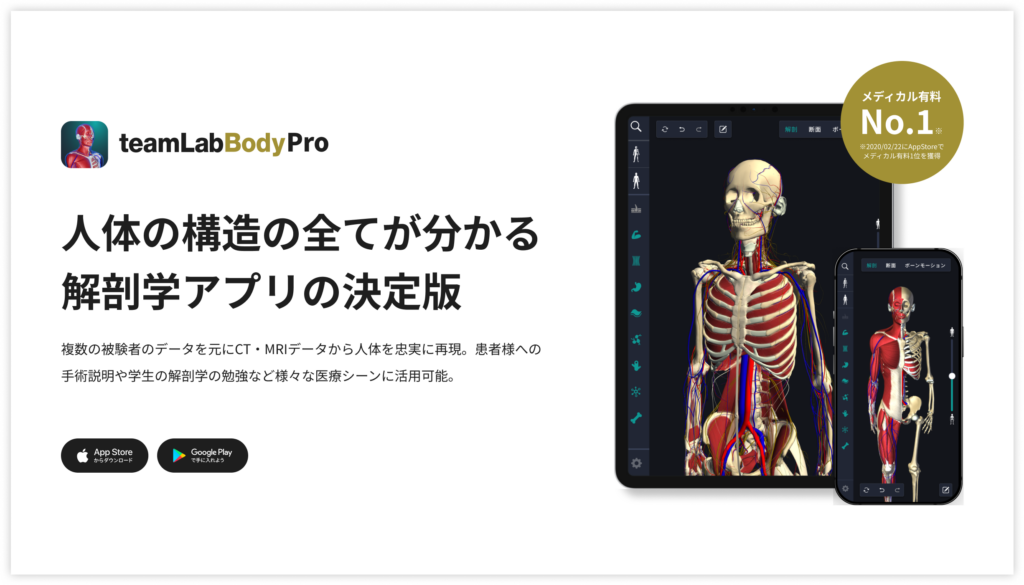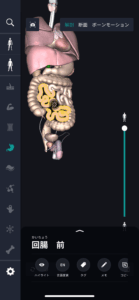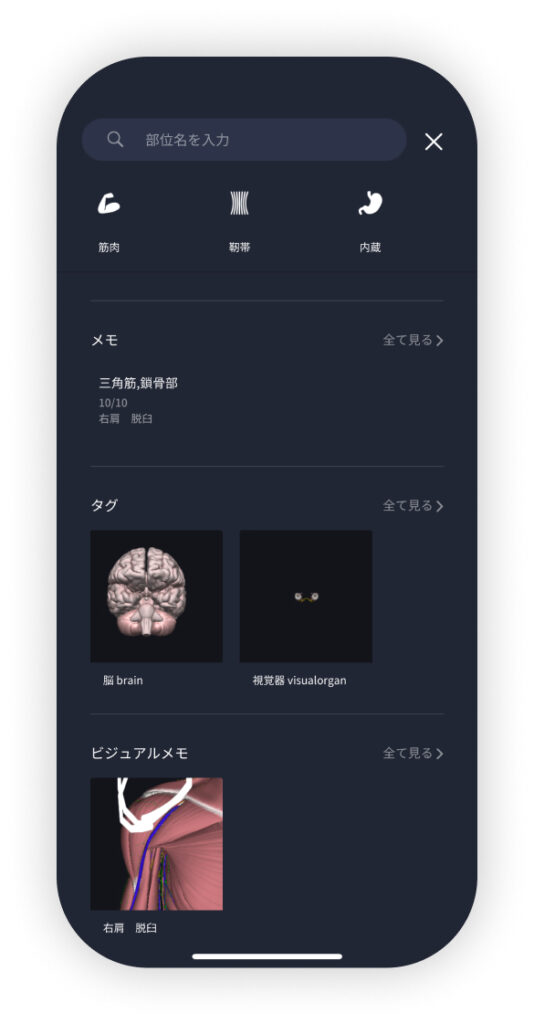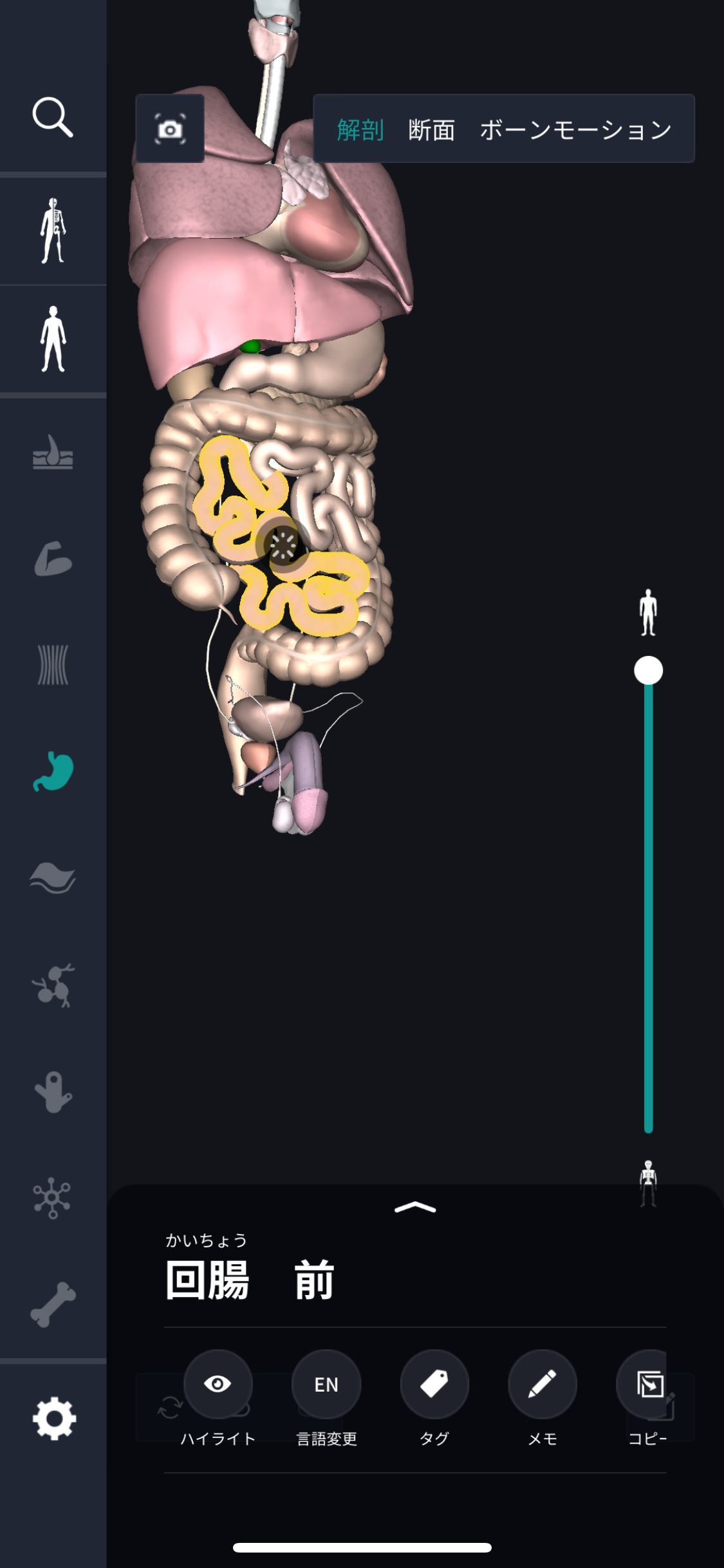beginning
In this article, I will explain effective study methods, starting with knowledge of specialized parts in human anatomy.
In human anatomy, it is necessary not only to memorize the names of various organs, muscles, and bones, but also to remember where they are located in the body. Therefore, it is necessary to learn as efficiently as possible.
I hope you can read this article and use the app to deepen your understanding even a little bit.
Now, I'll explain the details about the “ileum” and how to study human anatomy.
teamLab Body Pro Free Download
A 3D anatomy app that shows all the structures of the human body
Download teamLab Body Pro here!

What is the ileum?
In the anatomy application, you can view a selection of anatomy 3D models. In this model, there are various observation methods such as surfaces, cross-sections, and nervous systems. This time, I'll explain using an anatomy application.
About ileum

The ileum is a part of the small intestine and plays a very important role in the final stages of digestion. This is the last part of the small intestine and is the last transit point before food moves to the large intestine. After food has passed through the stomach and duodenum, most of the nutrients that remain unabsorbed are further digested here. The ileum is the longest part of the small intestine and usually accounts for about 60% of its total length. Normally, small projections called intestinal villi are tightly lined up inside, and this plays a role in absorbing digested nutrients. The ileum also has the role of sending substances from food left the stomach that have not been absorbed in nutrients to the large intestine. Another important function of the ileum is absorption of substances such as vitamin B12 and bile acids contained in food. These substances are very important for the health of the body, and B12 in particular is essential for the production of red blood cells. In this way, the ileum plays an important role in the absorption of nutrients and the final stages of digestion, and is part of an organ essential for maintaining the health of our body. It also coexists with bacteria in the ileum and has the function of supporting nutritional balance and immune function in the body. The ileum is delicate, and it is important to keep it healthy. By keeping a balanced diet and proper lifestyle habits in mind, you can keep your ileum healthy.
Study points
Location and structure of the ileum
The ileum (ileum) is the longest part of the small intestine, and usually makes up about 60% of the last small intestine, which is about 6 meters long, in an adult body. The ileum forms the final stage in the path of food passing through the stomach, and connects to the large intestine (colon). For this reason, it mainly plays an important role in nutrient absorption. Specifically, the inner wall of the ileum has countless protrusions called fine villi (villi), which make nutrient absorption more efficient. As a result, nutritional components (amino acids, sugar, fatty acids, etc.) broken down from food are taken into the body. Also, there is a structure called the ileocecal valve at the end of the ileum, which controls migration to the large intestine, prevents digestive matter from flowing back, and optimizes absorption of digestive juices and nutrients. The ileum also has a role in absorbing vitamin B12 necessary for the body and bile acids necessary for fat digestion. In particular, absorption of vitamin B12 takes place at the end of the ileum, and lack of this can cause health problems such as anemia. Overall, the ileum is an important part of the digestive system and is part of an organ that plays an important role in overall health.
The role and function of the ileum
Regarding the role and function of the ileum, it can be mentioned that it plays an important role in the digestive system. First, the ileum is mainly responsible for nutrient absorption, and it is the final step for incorporating nutrients into the body after food passes through the stomach and duodenum. In particular, vitamin B12, fat-soluble vitamins, minerals, etc. are effectively absorbed in the ileum. Furthermore, digestion of proteins and fats progresses in the ileum. As a result, nutrients broken down from food are taken into the body and become a necessary energy source. There are so many small projections called villi on the inner wall of the ileum, and this structure increases the surface area in contact with digestive substances and efficiently absorbs nutrients. This process maintains the body's nutritional status and contributes to overall health. In addition, the ileum also plays an important role in the body's immune function. A large number of immune cells are gathered in the intestines, and they work together with various gut bacteria that live there to support immune function in the body. This improves the intestinal environment and helps maintain good overall health. Through these roles, the ileum forms an important part of the digestive system and plays an important role in nutrient absorption and immune function enhancement. Maintaining a healthy ileum is critical to maintaining our health.
English notation for ileum
The English notation for ileum is “ileum.” The word comes from the Latin word “ilium” and refers to part of the intestine. The ileum is located at the bottom of the small intestine and makes up approximately 60% of the entire small intestine. The small intestine is located between the stomach and large intestine, and functions as the main place for digestion and nutrient absorption within it. The English notation “ileum” is widely used in drafts, academic papers, medicine, and anatomy. It is an important term for accurately describing anatomical structures and functions, especially for medical personnel and biologists. The ileum is an important digestive organ where after food passes through the stomach and duodenum, what remains with few nutrients absorbed is finally absorbed. It also plays an important role in the absorption of vitamin B12 and bile acids. Since there are many immune cells in this area, it contributes not only to digestion but also to supporting immune function. This promotes symbiosis with gut bacteria, and also plays a role in maintaining nutritional balance and health throughout the body. The ileum plays an extremely important role in the digestive tract as the backbone of digestion and absorption. It is known as “ileum” in English, and its role and structure are widely understood as basic knowledge in medical care.
How to study human anatomy
I will explain specific study methods using human anatomy applications.
Check your past learning history and practice repeatedly
Here are the steps to check your anatomy learning history and practice iteratively effectively.
1. Check your learning history in the app
Reviewing your learning history with the application is an important step in effectively advancing anatomy learning. First, launch the app and go to the learning history section from the main menu. Many anatomy apps are designed to show your progress in the form of graphs and lists, so you can visually check which parts you've learned about and how much time you've spent.
By using this data, you can understand which areas you have strengths in and where you need to spend more time and effort. We also recommend using a dedicated tag or notebook function to mark areas you are particularly weak at or where you need to relearn. Regularly checking your learning history and looking back on past learning content will lead to efficient review and deepening understanding.
2.Make a plan for iterative learning
Making an efficient repetitive learning plan based on learning history is extremely effective in promoting knowledge retention. First, identify weak points and areas where you need to relearn. Next, arrange these study items into a weekly or monthly calendar and create a specific study schedule. By proceeding in a planned manner, you can learn each part evenly and avoid packing in a large amount of information at once.
Using a task management app or digital calendar to set study reminders is effective. Also, it's important to have the flexibility to regularly review progress and revise plans as needed. By having goals and proceeding with your studies in a planned manner, you can efficiently acquire anatomical knowledge.
3.Use 3D features to learn visually
By utilizing the 3D function, learning anatomy is easier to understand visually. The 3D model shows the structure of the human body three-dimensionally, and each part can be observed in detail. This makes it possible to intuitively grasp positional relationships between deep muscles and organs that are difficult to capture in a planar view. For example, you can learn even the smallest details by rotating specific muscles and bones and zooming in and out.
Also, there are many apps that have the function of displaying cross-sectional views of each part using a 3D model, which is useful for deepening understanding of internal structures. This diversity of visual information helps with memory retention and improves immediate responsiveness in tests and practice situations. By utilizing the 3D function and learning visually, you can learn anatomy knowledge more deeply and efficiently.
Use the memo function concretely

Make notes so you don't forget the things and points you've noticed while studying. The memo function can be used for different purposes, such as inputting text, saving images, and writing memos. Tag your notes to make them easier to review later.
Test your learning regularly in the form of quizzes
Regularly testing what you've learned in a quiz format is a very effective way to anchor your anatomy knowledge. Quiz-style tests help you objectively grasp your level of understanding and areas you lack while repeating knowledge.
For example, by using a learning app to conduct quizzes every specific period, you can reconfirm what you've learned and strengthen your memory. There are a wide range of quiz formats, such as multiple choice questions, fill-in-the-blank questions, and short answer questions, and each helps understanding from a different angle and develops the ability to utilize various types of knowledge.
Get feedback
If possible, get feedback from other learners and experts. It helps you find your own gaps in understanding and areas for improvement. You can also keep yourself motivated to learn by regularly testing yourself. Feeling a sense of accomplishment and progress increases motivation for continuous learning.
summary
This time, I explained how to study “ileum” using an application!
Thank you for reading this far.
I would be happy if reading this article helped you learn about anatomy.
Learning is a long, never-ending journey, but I sincerely wish you all the best. Let's continue to study together and work hard for the national exam!
Please look forward to the next blog.



